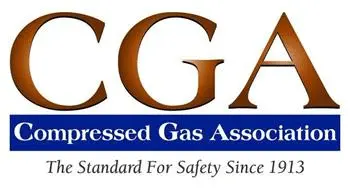CGA: Compressed Gas Association, Inc.

CGA, the Compressed Gas Association, is a nonprofit organization that develops and publishes standards related to the equipment and supply chain used in the compressed gas industry. Headquartered near Washington, D.C., United States, CGA standards have been adopted by governmental agencies in the United States and Canada. CGA standards are agreed upon by over 125 contributing member companies across the world. CGA also serves as the administrator for the U.S. TAGs (United States Technical Advisory Group) to ISO/TCs 58, 197 and 220 (International Organization for Standardization/Technical Committee) and to many of the subcommittees for ISO/TC 58. Standards from CGA are available both individually, directly through the ANSI webstore, and as part of a Standards Subscription. If you or your organization are interested in easy, managed, online access to standards that can be shared, a Standards Subscription may be what you need - please contact us at: [email protected] or 1-212-642-4980 or Request Proposal Price.
Below are CGA's best-selling standards. To find additional standards, please use the search bar above.
CGA P-1-2015
Standard for Safe Handling of Compressed Gases in Containers - 12th Edition
Users of compressed gas shall become familiar with the properties and inherent hazards of the products they use.áValuable information about each specific gas is contained in its product labeling and safety data sheet (SDS). Read this information and inform others of the importance of understanding and applying the precautions established within the available safety literature.
CGA G-5.5-2014
Hydrogen Vent Systems
This publication presents design guidelines for hydrogen vent systems used in gaseous and liquid hydrogen systems at user sites and provides recommendations for safe operation of these vents. It begins at the discharge port of safety devices and other components that control the release of hydrogen and ends at the point where hydrogen concentration in the atmosphere is below the lower flammable limits. It also provides information on the production, transportation, handling, and storage of compressed hydrogen, cryogenic liquid hydrogen, and related products. Additional information on hydrogen can be found in CGA G-5,Hydrogen, CGA G-5.4, Standard for Hydrogen Piping Systems at User Locations, CGA Handbook of Compressed Gases, and NFPA 55, Compressed Gases and Cryogenic Fluids Code [1, 2, 3, 4].1Pressure relief devices (PRDs) for cylinders and tube trailers required by U.S. Department of Transportation(DOT) in Title 49 of the U.S Code of Federal Regulations (49 CFR) are not covered in the scope of this publication[5].
CGA C-6-2019
Standard for Visual Inspection of Steel Compressed Gas Cylinders - 12th Edition
This standard provides cylinder users (requalifiers, owners, fillers, operators, etc.) with criteria to accept, reject, and condemn steel compressed gas cylinders.
ANSI/CGA G-2.1-2014
Requirements for the Storage and Handling of Anhydrous Ammonia (an American National Standard)
This standard is intended to apply to the design, construction, repair, alteration, location, installation, and operation of anhydrous ammonia systems including refrigerated ammonia storage systems.
CGA G-7.1-2018
Commodity Specification for Air - Seventh Edition
Describes the specification requirements for air including atmospheric air and air synthesized by blending oxygen and nitrogen in the proper proportions. Atmospheric air contains a large variety of trace constituents. It is impractical to set individual limits for many of these; however, this specification qualifies certain grades of air by limiting the concentrations of specific trace constituents.
CGA G-4.1-2018
Cleaning Equipment for Oxygen Service - seventh edition
This publication describes the cleaning methods and requirements for equipment used in the production, storage, distribution, and use of liquid and gaseous oxygen to reduce the risk of fire, explosion, or promotion of combustion. Cleaning in accordance with this publication is required for all surfaces in contact with a gas or liquid that has an oxygen concentration greater than 23.5%. Examples of such equipment include stationary storage tanks, road tankers, and rail cars; pressure vessels such as heat exchangers and distillation columns; compressors and pumps; and associated piping, valves, and instrumentation. However, the cleaning methods and requirements are not limited to this equipment. With modifications, these methods may be used for cleaning other oxygen and oxidizer (e.g., fluorine, nitrogen trifluoride, nitrous oxide) service equipment such as cylinders, cylinder valves, cylinder regulators, welding torches, and pipelines where regulatory requirements do not specify cleaning methods.
CGA C-6.3-2019
Visual Inspection of Low Pressure Aluminum Alloy Compressed Gas Cylinders - Fourth Edition
This publication covers the periodic inspection of aluminum alloy compressed gas cylinders with service pressures of 500 psi (35 bar) or less. This publication may not cover all circumstances for each individual cylinder type or lading. Inspection agencies may find it necessary to amplify these requirements to fit their condition of service if the service is more severe than encountered in transportation
ANSI/CGA G-13-2015
Storage and Handling of Silane and Silane Mixtures (an American National Standard) - 3rd Edition
This standard governs the installation of systems and sources that are used to store, transfer, or contain silane or silane mixtures. This standard includes guidance for siting, design of equipment, piping and controls, and the fabrication and installation of silane gas storage and closed-use systems. Additional guidance on operational steps associated with the use of silane and silane mixtures as well as fire protection, gas monitoring, ventilation, and related safeguards are provided.
ANSI/CGA M-1-2018
Standard for Medical Gas Supply Systems at Health Care Facilities - 4th Edition
This standard provides the minimum requirements for the design, installation, maintenance, testing, and removal of CMG supply systems at health care facilities. For facilities that are solely intended for use in non-human applications (i.e., veterinary or pharmaceutical), the applicability of this standard is to be determined by the CMG system designer, authority having jurisdiction (AHJ), or other related parties based on facility requirements. Strict adherence to CGMP shall be taken into account to prevent adulteration of the CMG.
ANSI/CGA P-18-2020
Bulk Inert Gas Systems - Fifth Edition
This standard contains minimum requirements for locating/siting, selecting equipment, installing, starting up, maintaining, and removing bulk inert gas supply systems.





